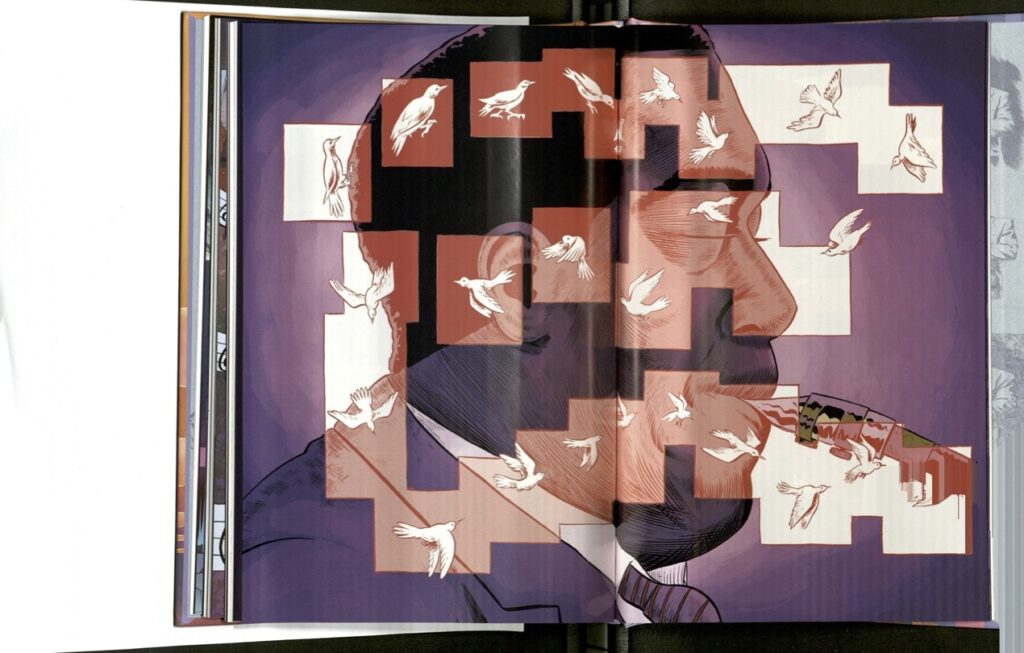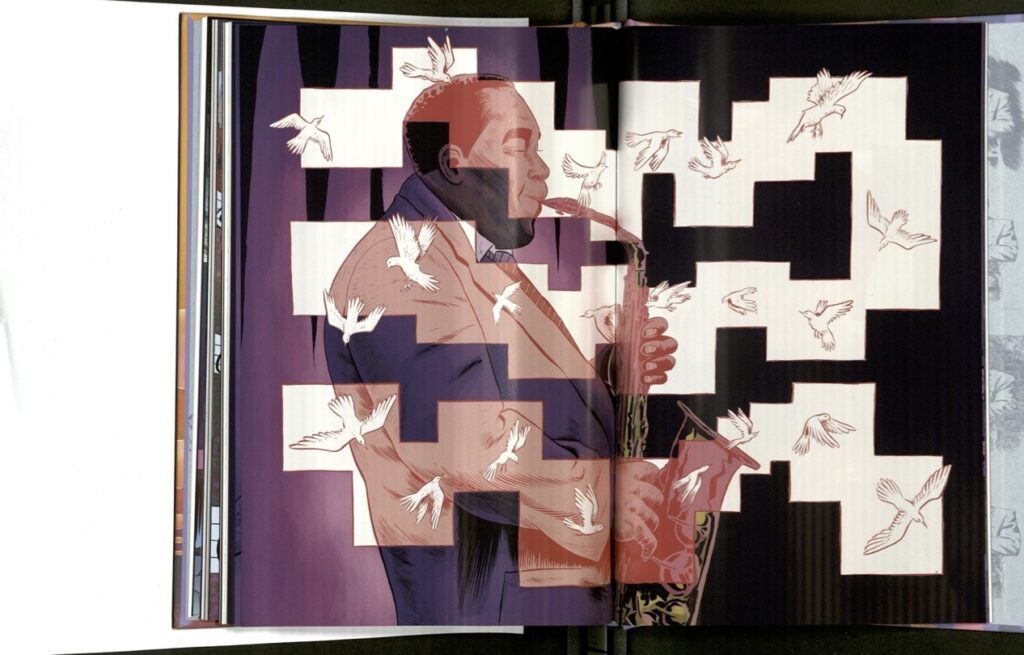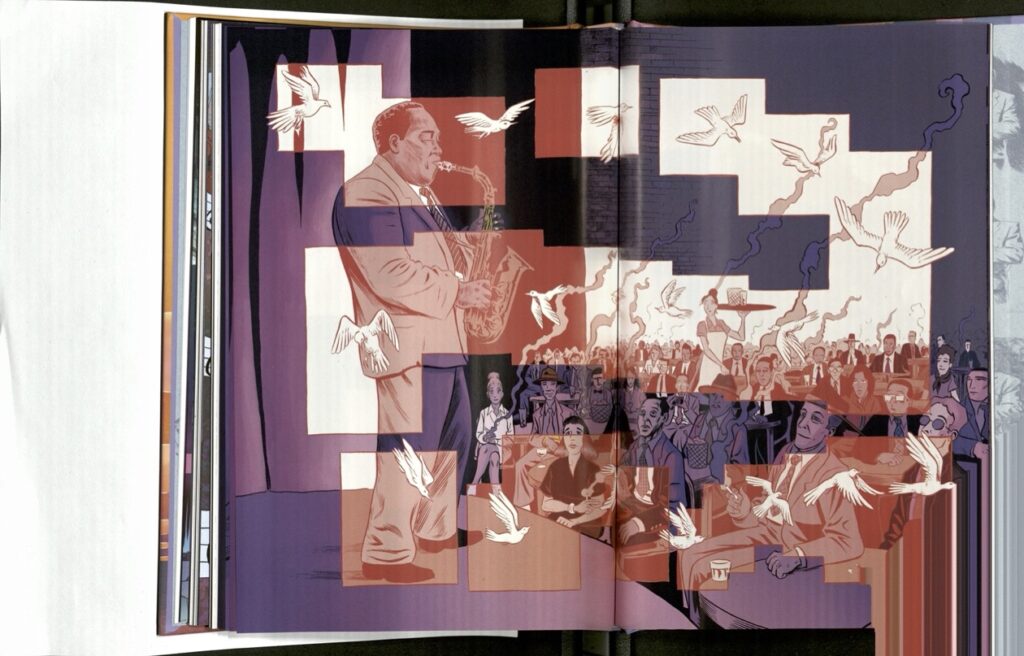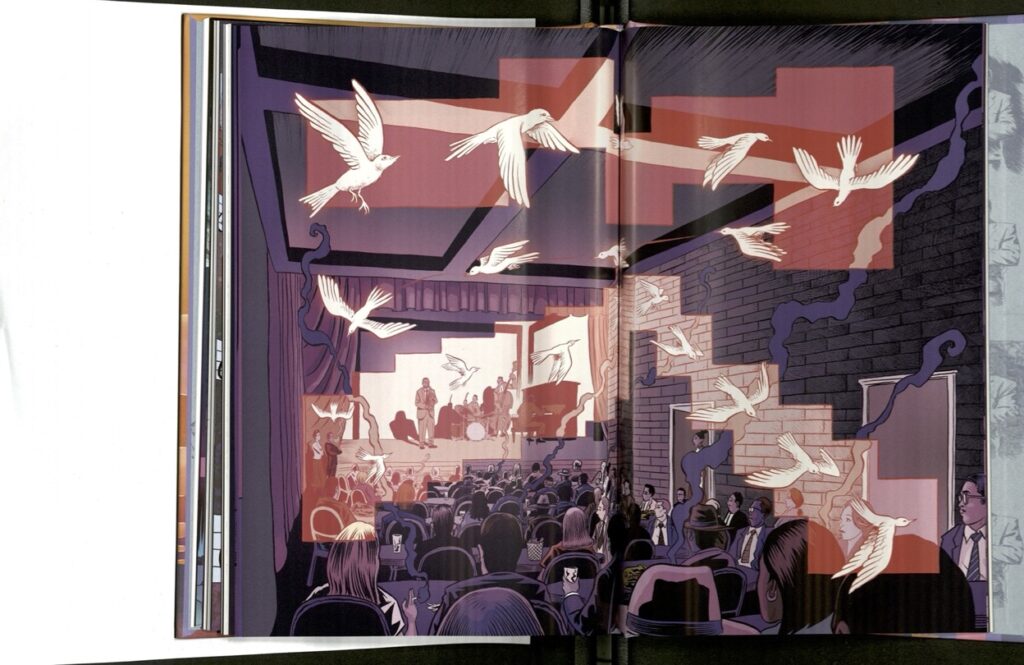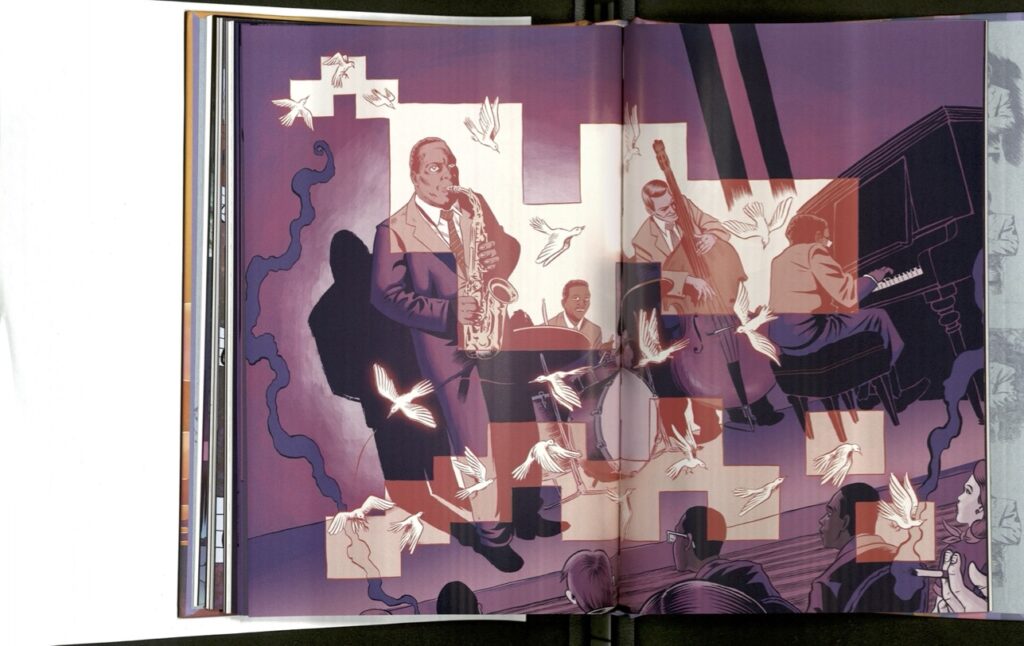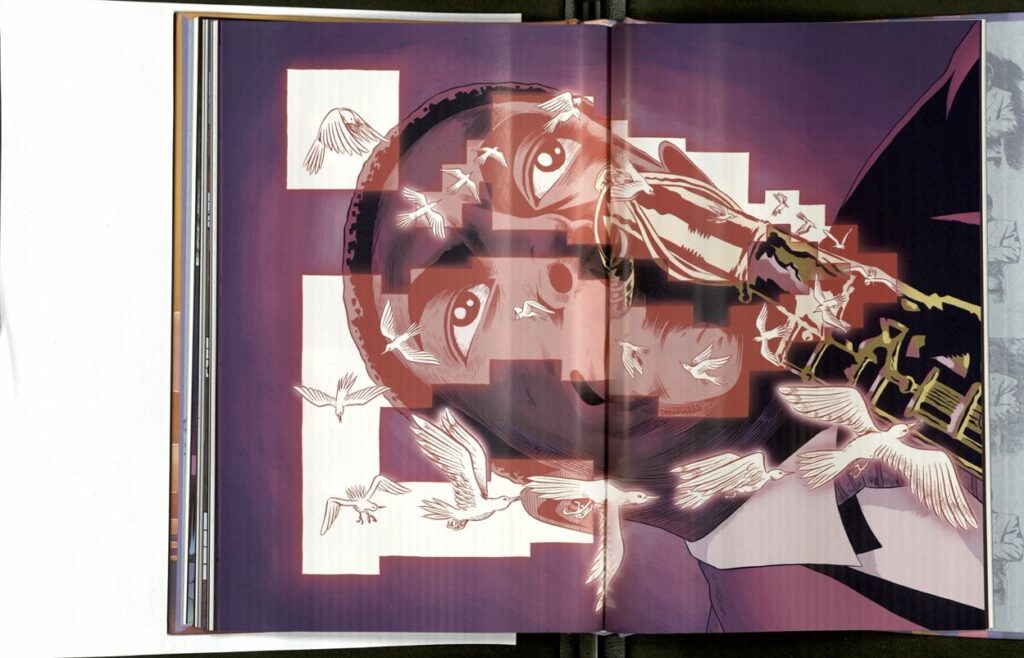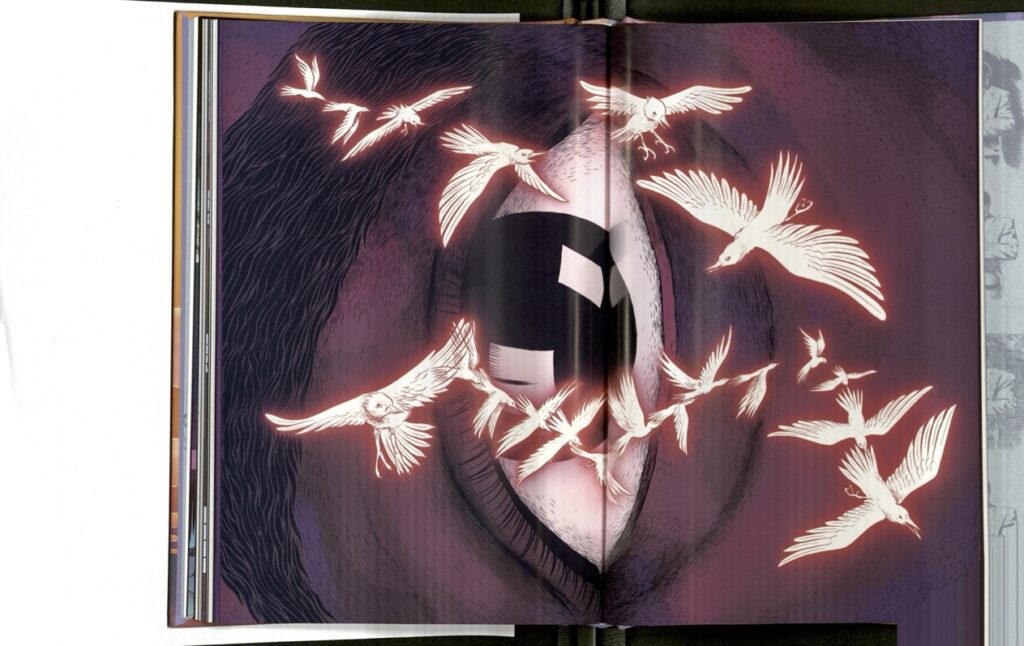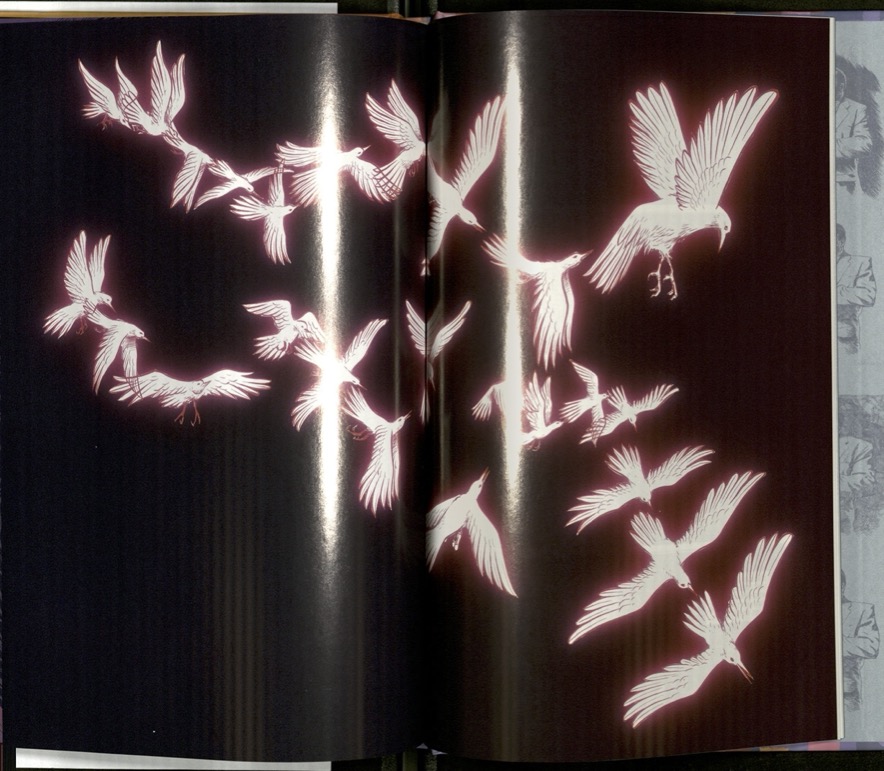Much like a drummer in a band, music can set the rhythm and pace of a comic. The most common depictions of music in comics involve singers or instruments. The difference between these two groups is their visuals; whereas lyrical songs rely on speech bubbles to signify the presence of a sound, instrumental songs involve onomatopoeia-style depictions. Both groups rely on standard musical notation symbols, as well. In terms of the purpose of music in comics, music serves to drive the narrative of a comic, amplify the surrounding environment both visually and temporally, and characterize various figures. The first page of this section explores vocal and instrumental visualizations, as well as several other types of visualizations, and the second page delves into the three main purposes.
Explore Visual Forms
Explore Purpose
Visual Forms
Vocals
Music with vocals conveys sound through speech bubbles. Due to the fact that speech bubbles primarily depict dialogue, their usage for lyrics is logical because both lyrics and dialogue are, in a sense, spoken words. However, the speech bubbles for vocals differentiate between spoken and sung words. These manipulations can include changes in font, changes in the shape of the bubble, and the incorporation of music notes.
Instruments
In contrast to vocals, instruments and instrumentalists convey music through onomatopoetic indicators. Such a form of expression comes from the idea that onomatopoeiae express impact and movement, and the physical act of playing instruments aligns with these concepts. For instance, “BANG!” could be used to depict a drum because the performer is hitting the instrument, making it the sound of an impact. Explosion or movement lines can accompany these depictions to reinforce the sense of action.

Elvira Mistress of the Dark #139, “Broadway Sorcery of 2004,” November 2004
Writer: Frank Strom
Artist: Anna-Maria Cool
Letterer: Thom Zahler
Publisher: Claypool Comics
Page 6
In this issue of Elvira Mistress of the Dark, Elvira inserts herself into a musical and then enchants the performers to follow her music and stage directions. This panel of several singers posing around Elvira as they sing to her features an allusion to the song “Consider Yourself” from the musical Oliver. Such a panel is a prime example of the difference between the depictions of lyrics and instruments. Lyrics like the ones sung by the swing cast are enveloped within a speech bubble and surrounded by musical symbols. In addition, the speech bubbles are rippled, as opposed to the smooth and rounded nature of conventional speech bubbles, which illustrates that the words are not spoken but instead have some other quality and inflection, in this case being sung.
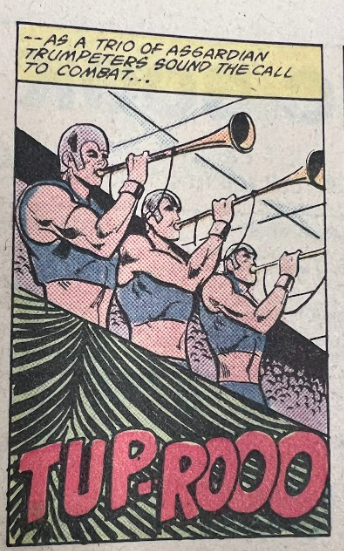
Dazzler #16, “Black Magic Woman,” June 1982
Writer: Danny Fingeroth
Penciller: Frank Springer
Inker: Vince Colletta
Colorist: Don Warfield
Letterer: Janice Chiang
Publisher: Marvel Comics
Page 14
This page from Dazzler #16 illustrates the common depiction of instruments in comics. The horns of the Asgardians are drawn with conventional sound effects stylings, including a bold font, capitalization, and enlarged letters that zigzag across the bottom of the panel. Likewise, the word “tup-roo” is, in and of itself, an onomatopoeia. As evidenced by this panel, music that comes from instruments is closely associated both aurally and visually with sounds of onomatopoeia and is therefore drawn to emulate them, especially when put in contrast with music that is sung and performed by vocalists.
Other Types of Visualizations
Musical depictions exist beyond these conventional forms, however. Comics adopt unique symbols and styles to reinforce the presence of music in ways other than music notes or onomatopoeiae. In addition, the facial expressions of a performer can suggest the presence of music within a scene and reinforce the diegetic nature of the sound.
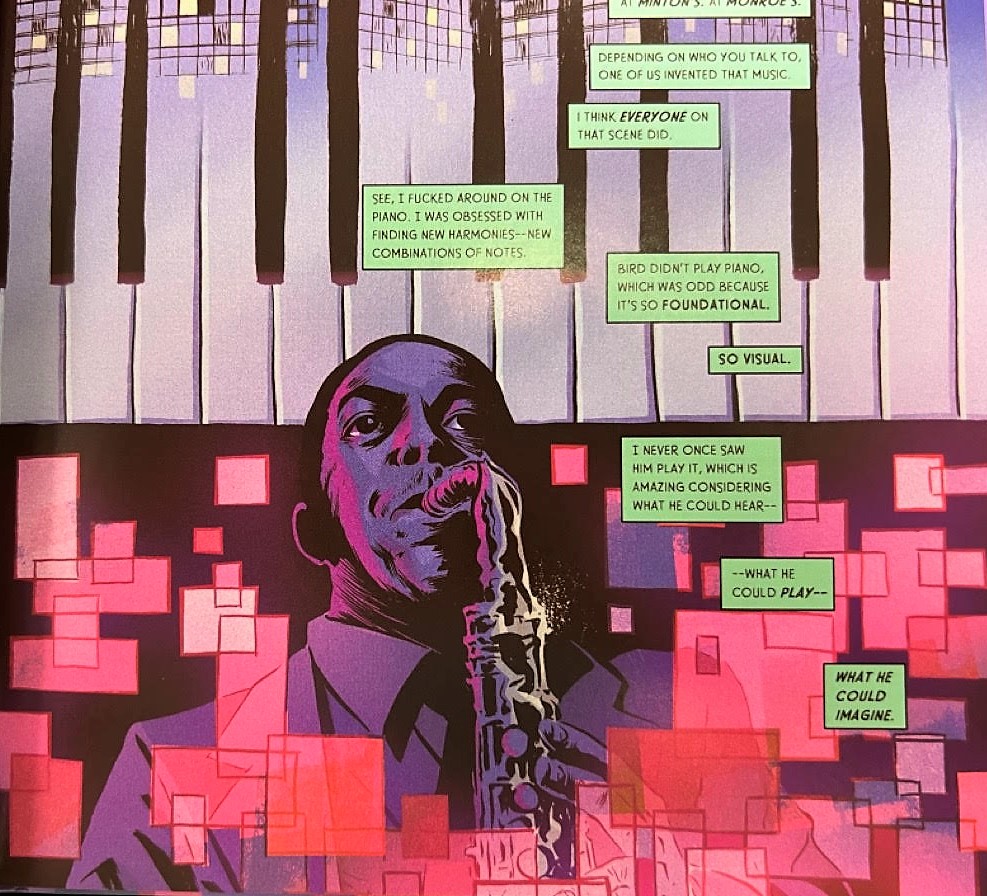
Chasing the Bird: Charlie Parker in California, 2020
Author: Dave Chisholm
Colors By: Peter Markowski
Publisher: Z2 Comics
Page 22
Sometimes, creators, such as those that developed Chasing the Bird, illustrate sound through nontraditional symbols in order to convey the contrast from one performer to another. For example, the music of Charlie Parker, known as a revolutionary jazz saxophonist, is depicted as a series of floating pink rectangles of varying size and width. Such a depiction accentuates Parker’s diversion from the norms of music, as well as the improvisational style of jazz. In addition, while the music of other performers is also portrayed with squares, they are never pink, which further underscores Parker’s unique qualities as a musician. In terms of facial expression, Parker’s mouth conforms to meet the mouthpiece of the saxophone, which heightens the realism of his composition and suggests to the audience that he is truly blowing on his instrument.
View More Examples of Visualizations
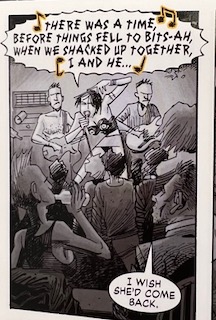
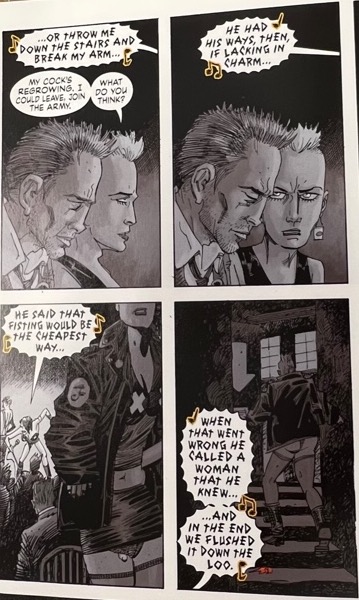
League of Extraordinary Gentlemen Century, “1969: Paint it Black,’ July 27, 2011
Writer: Alan Moore
Artist: Kevin O-Neil
Colorist: Ben DiMagmaliw
Letterer: Todd Klein
Publisher: Top Shelf Productions
Pages 38-39
In addition to the distinction between sung lyrics and music from instruments, there can also be distinctions between different genres of music and comics. In this scene, two characters meet at a bar with a band. The grunge of the clothing of the band members and the bar suggest the punk-rock style of the band, which is reinforced by the formatting of the music. While the speech bubbles in the scene are smooth and in a conventional comic style font, the song lyrics have a larger, sharper font and are within jagged speech bubbles, accentuating their difference from both the spoken words and other styles of music. The music notes are also the only source of color in the comic, which could perhaps visually represent the way that the music punctures and interjects within the scene.
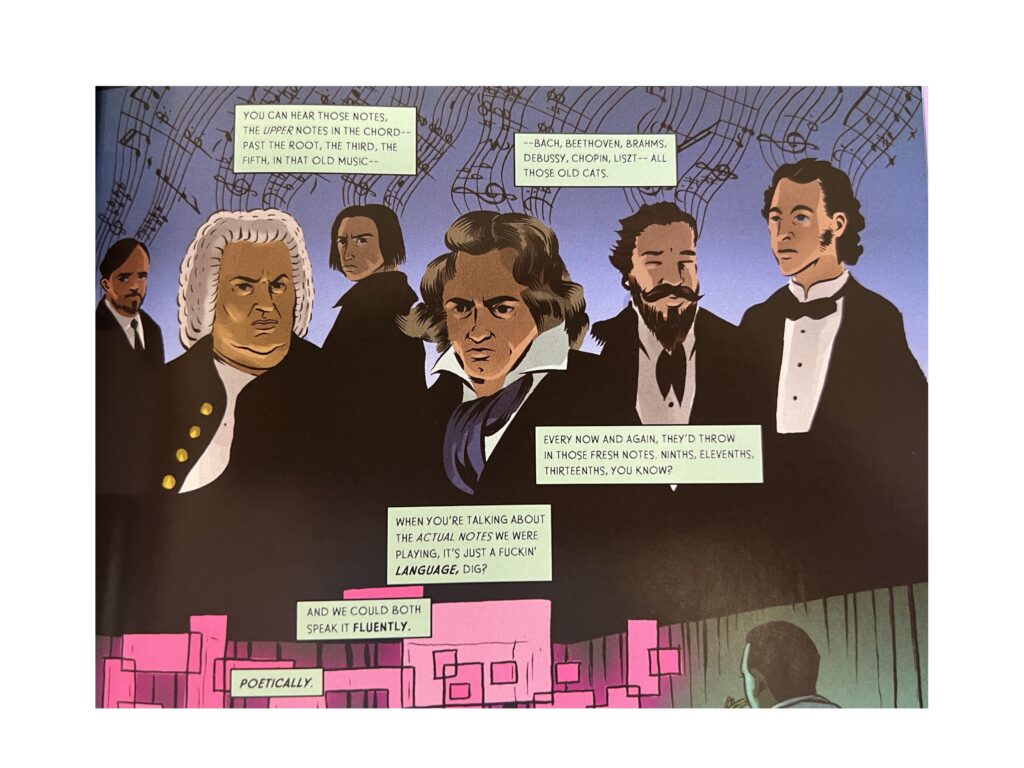
Chasing the Bird: Charlie Parker in California, 2020
Author: Dave Chisholm
Colors By: Peter Markowski
Publisher: Z2 Comics
Page 23
Depictions of music can also differ in terms of the music selection itself. Sometimes, comic creators will include songs that they wrote for their specific work, while others include music that already exists in real-life. In Chasing the Bird, for example, several famous European composers are depicted to show the changes in music over time. These composers include Bach, Beethoven, Brahms, Debussy, and Chopin. In addition to illustrating their portraits, the graphic novel includes staves of music that flow from each of the heads of the composers. However, instead of a series of disconnected notes or musical symbols, these staves are actual selections from the composers’ most famous works. Therefore, in this case, the creators chose preexisting music that help characterize the composers and their musical abilities.
Chasing the Bird: Charlie Parker in California, 2020
Author: Dave Chisholm
Colors By: Peter Markowski
Publisher: Z2 Comics
Pages 137-155
At the end of Chasing the Bird, the depiction of instrumental music is once again conveyed through unconventional symbolic representations of music. Instead of just the pink squares from the rest of the novel, Charlie Parker’s performance begins with a bird that is at rest enveloped within a pink box. The bird and box begin by sitting on the back of his head and then both shift to the mouth of his instrument and then across his body, making their way into the audience. As the bird soars through the performance hall, its wings expand and the boxes start to lose their uniform shape. By the end of the sequence, only the bird remains, and even the background environment and Charlie himself have disappeared. In this case, the bird is a new symbolic portrayal of music that captures the free, loose, and unhindered nature of his playing. The selection of the bird is also important because it is a reference to his nicknames, which were “Bird” or “Yardbird,” so drawing it within the musical depictions suggests that Parker is putting his whole self into his music in this final performance.
Click on the blue circles to progress the pages.
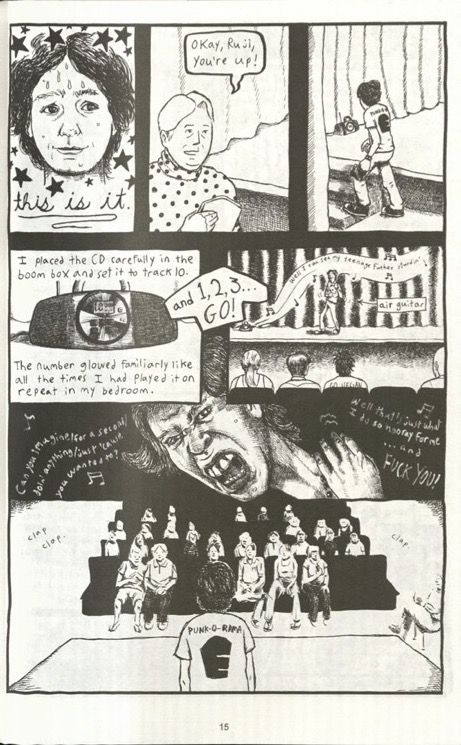
Side A: The Music Lover’s Graphic Novel, “Last Act,” 2006
Writer and Artist: Rebecca “Ruji” Chapnik
Page 15
Often, the presence and style of music are also conveyed in comics through the facial expressions of the performer. These expressions can reinforce the genre of the music or the intensity of the moment. On this page, for example, the singer is drawn with exaggerated facial expressions and sharp shadowing, both of which are qualities commonly associated with punk rock, which is the style of the vocalist. In addition, the harsh lyrics work in tandem with the intense facial expressions to illustrate to the audience that the singer is passionate about their work.
Lorem ipsum dolor sit amet, consectetur adipiscing elit. Ut elit tellus, luctus nec ullamcorper mattis, pulvinar dapibus leo.
Lorem ipsum dolor sit amet, consectetur adipiscing elit. Ut elit tellus, luctus nec ullamcorper mattis, pulvinar dapibus leo.
Continue onto Page 2 to explore Music and Purpose
